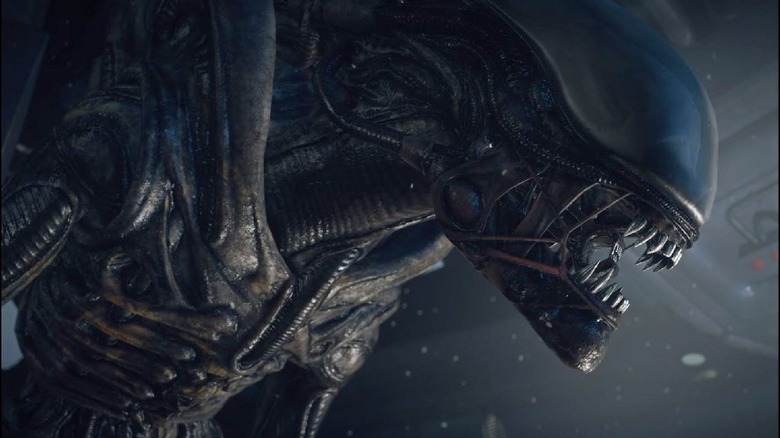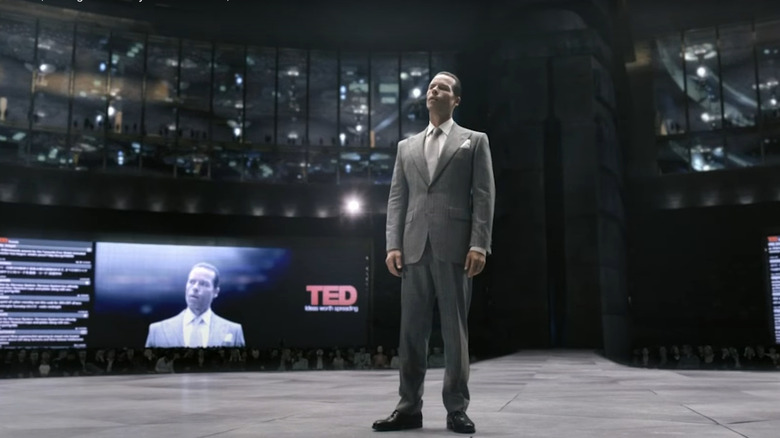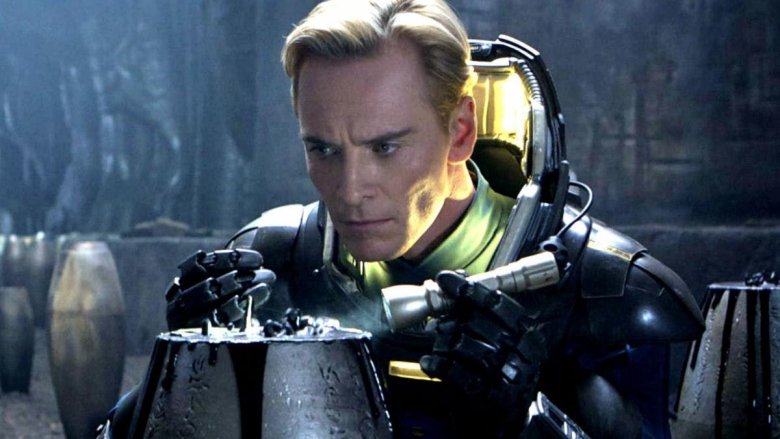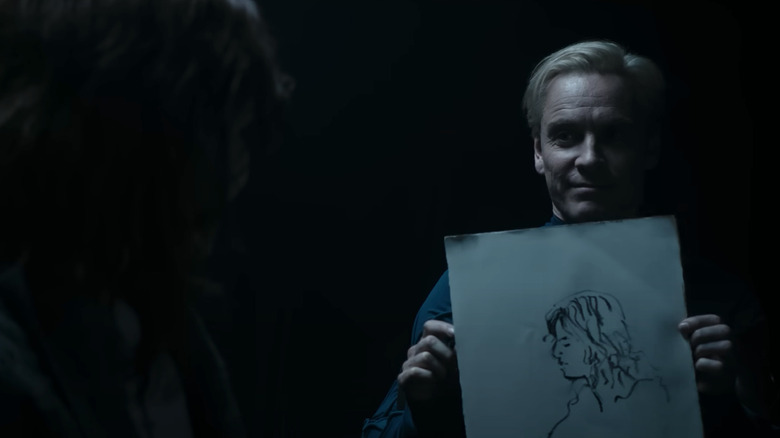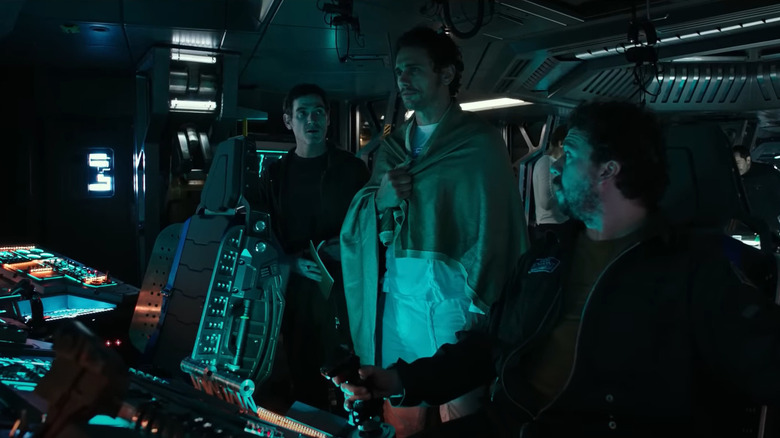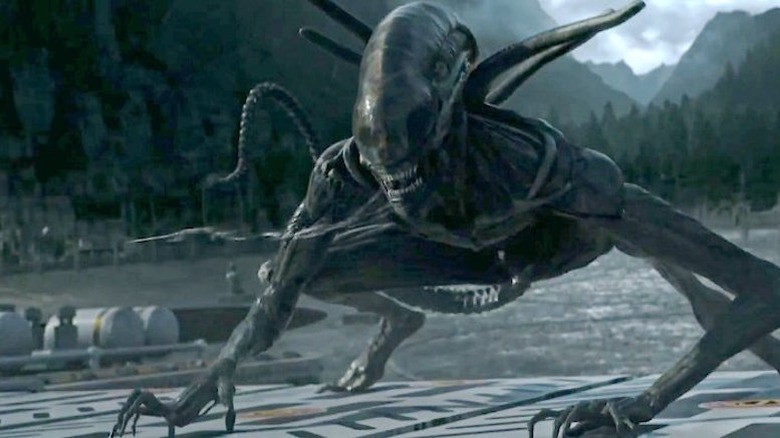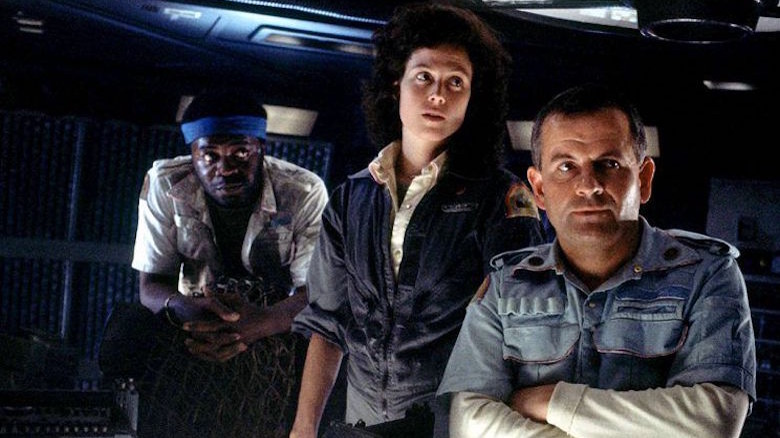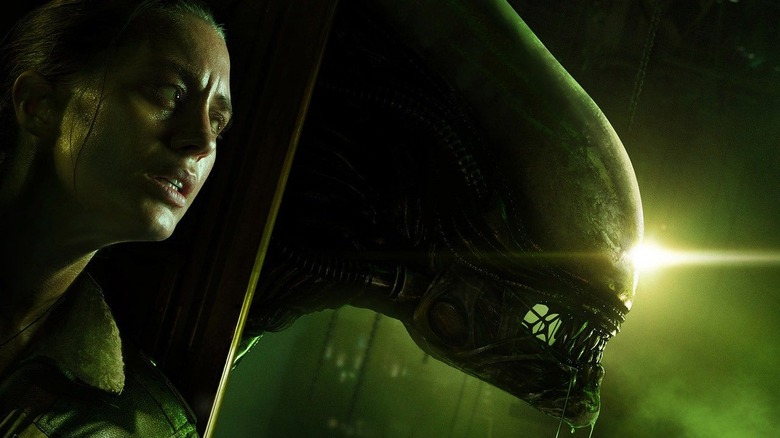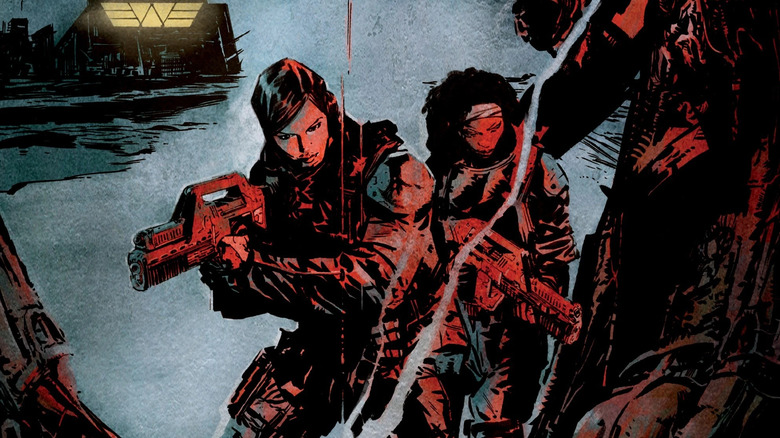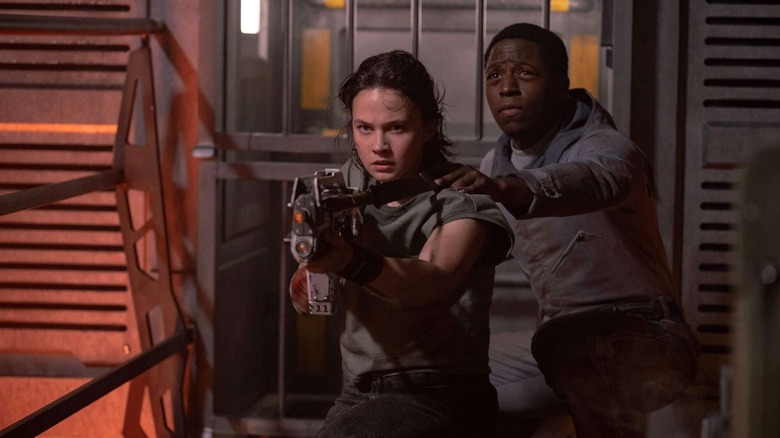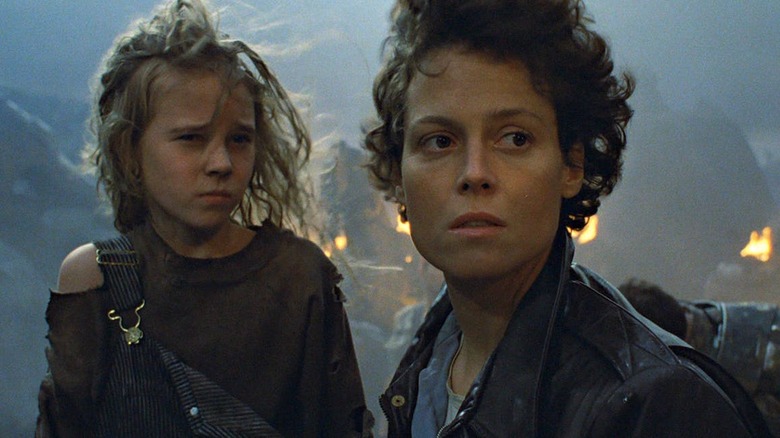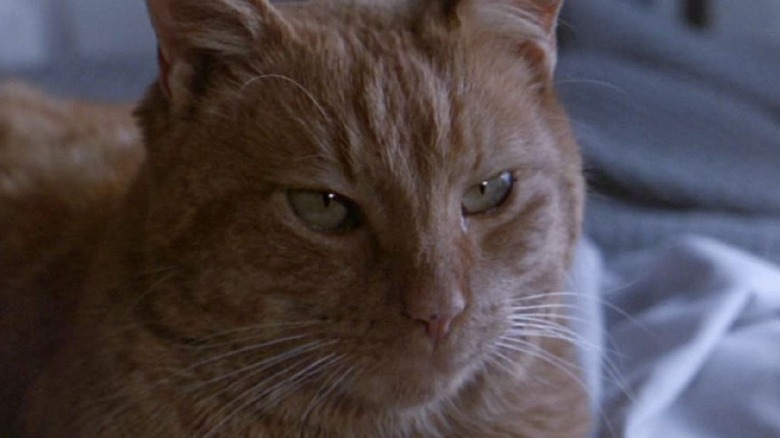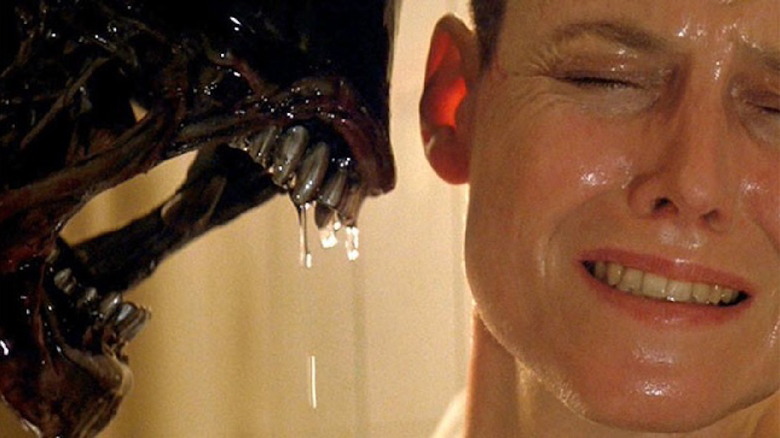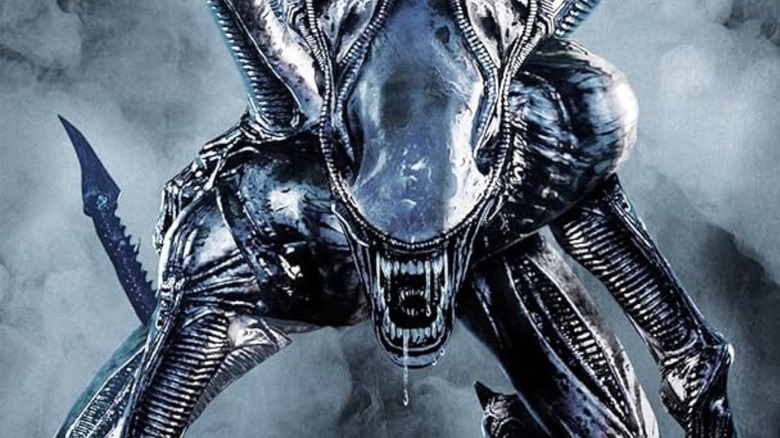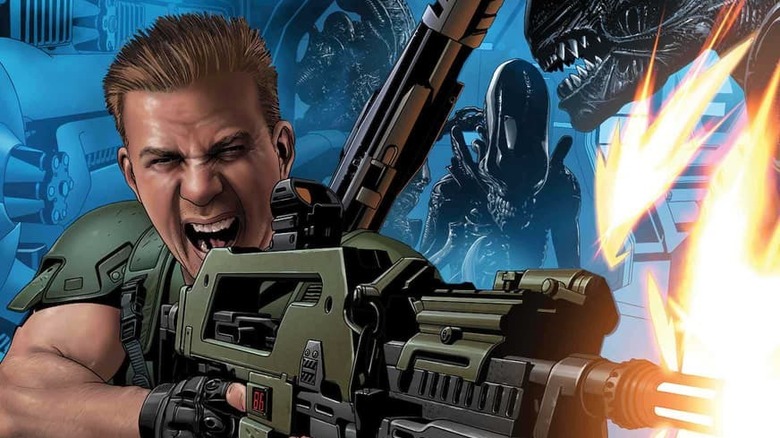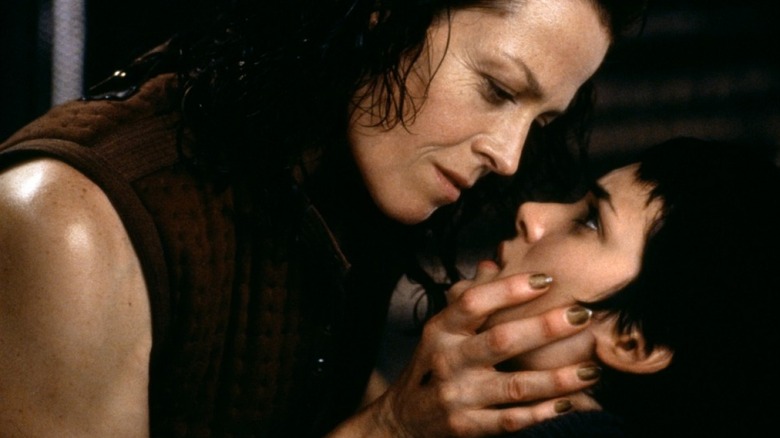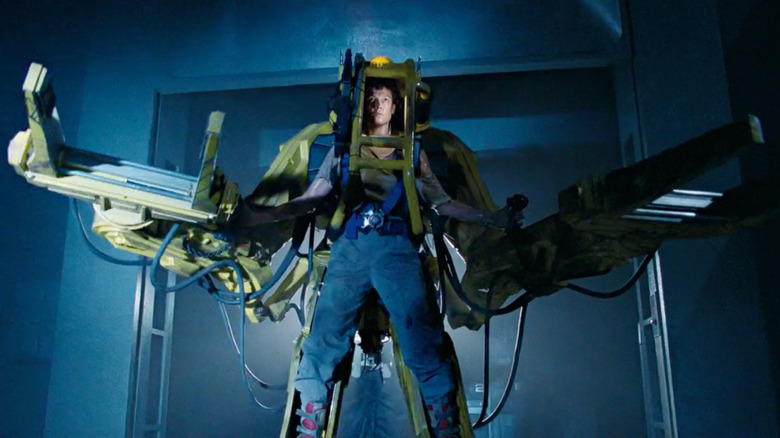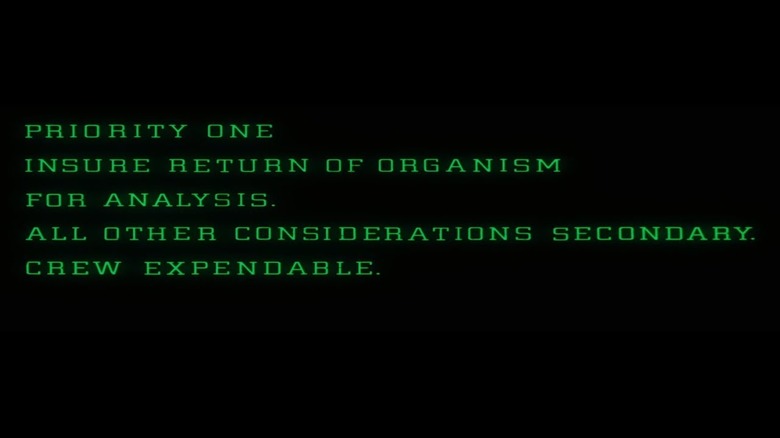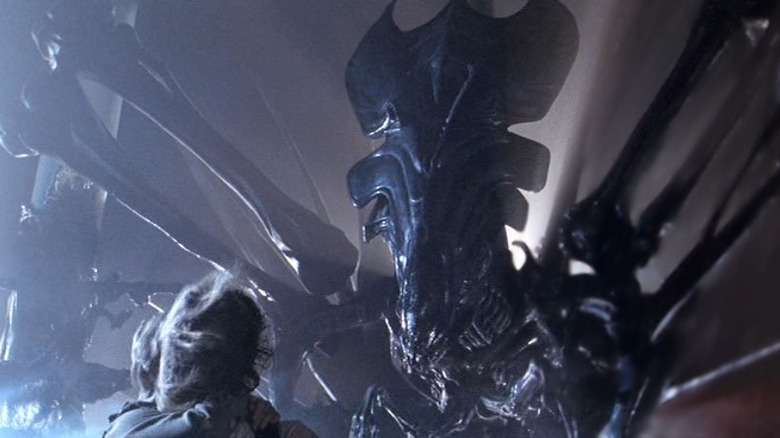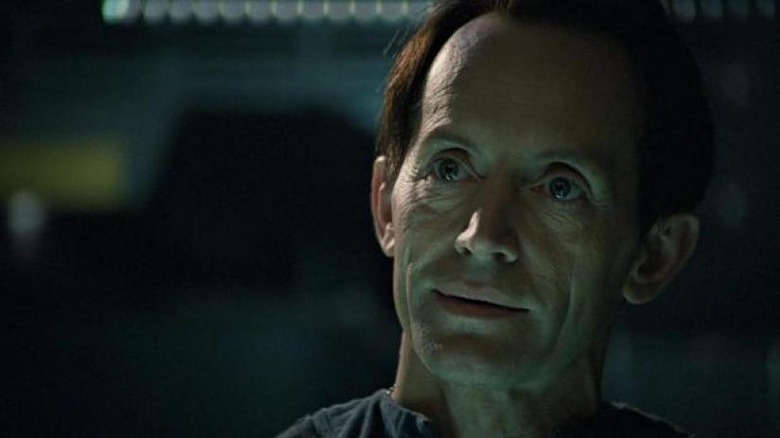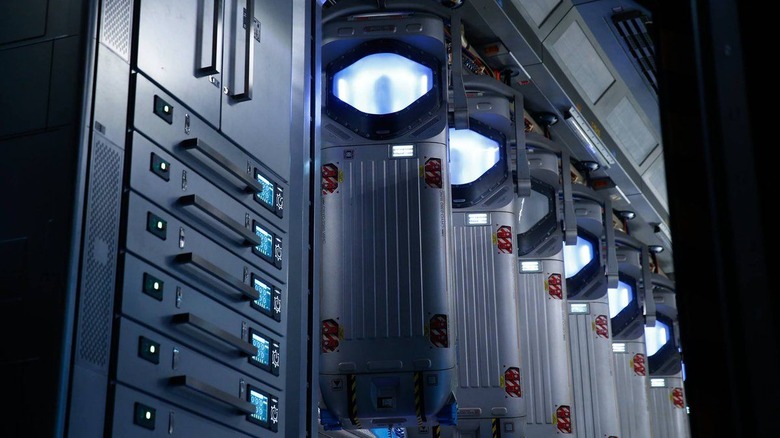The Entire Alien Story Finally Explained
Deep in space, millions of miles from Earth, the "Alien" series explores not only new worlds, but the development of one of the most deadly creatures that has ever existed. From the mind of artist H.R. Giger came the Xenomorph — a steampunk hybrid alien creature with a metallic appearance, razor teeth, and acid for blood — to terrorize a series of humans as it eats its way across the universe. The Xenomorph has many nemeses, its most formidable being Ellen Ripley (Sigourney Weaver), who battles the monster over the course of several hundred years. But as explored in the "Alien" prequels, the creature's story is far more involved than simply "space monster versus humans."
With films directed by cinema legends Ridley Scott, James Cameron, David Fincher, Jean-Pierre Jeunet, and Fede Álvarez, this sci-fi/horror series has often transcended the pulp status afforded most entries in the genre. In particular, the early films, "Alien" and "Aliens," are such masterworks that their influence on pop culture is difficult to overstate. The "Alien" franchise has made an indelible mark on film history and future — but with prequels and sequels in multiple forms of media expanding the original story over a span of several decades, it can be hard to untangle what's really going on here. What's the "Alien" saga really about? Let's explore.
In the beginning: Weyland Corp and Prometheus
Our journey through the "Alien" timeline begins in the (in-universe) year 2012, when British tech entrepreneur and inventor Peter Weyland (Guy Pearce) establishes Weyland Corp at the age of 22. (Fittingly, this is the same year that the film "Prometheus" was released in the real world as the true origin story of the "Alien" franchise.) A little over a decade later in 2023, Weyland gives a TED Talk in Long Beach, California, where he explicitly expresses his ambitions to lead humanity toward the godhood that supposedly awaits it. As part of this mission, he asserts his disdain for rules that would keep the world from its destiny — but, most importantly, those that would separate him from his own scientific goals.
The pinnacle of those goals are synthetics — androids that are visually, contextually, and intellectually indistinguishable from humans. As the face of this new scientific and technological achievement, Weyland Corp presents David (Michael Fassbender), introducing him in 2079 through an advertisement celebrating his "birthday." Among the traits that David offers to potential buyers are the abilities to blend in with the crew, communicate logically and without emotion, and carry out orders which humans may find ethically challenging.
But while Weyland Corp makes advancements on Earth, there are those looking beyond. In 2089, Dr. Elizabeth Shaw (Noomi Rapace) spends over a month sending daily video messages to Weyland, asking him for help on a new scientific venture that could answer life's most elusive questions.
Prometheus
Ridley Scott's 2012 prequel "Prometheus" begins when a protohuman on Earth drinks a deadly poison that kills him and dissolves his body into strands of human DNA that is then dosed into the water supply. Several million years later, Dr. Elizabeth Shaw believes she has found a map and an invitation to the planet where these protohumans originated. She calls them Engineers, and she believes they want to meet their "children."
Shaw and a scientific crew are hired by the Weyland Corporation to find the Engineers on Planet LV223, and after a great deal of trouble, they arrive. But the Engineers are all dead. Their spacecraft is filled with jars of toxic black goo corresponding to egg-like sacs lining the ship that begin to open after signs of life appear. Yes, Dr. Shaw finds her Engineers, but what she doesn't expect to find is that the Engineers had set a course to Earth with the intention of wiping out the human race they had created.
The Engineers never get their chance as they are wiped out by an ever-evolving Neomorph — the predecessor to the Xenomorph seen later in the series. The android David, who has now developed a healthy strain of megalomania, decides to take up the Engineers' mantle and infect the human crew. After chaos, destruction, and an encounter with a revived Engineer who's hostile toward humans, David and Dr. Shaw escape. But as "Prometheus" comes to an end, Shaw's new obsession is understanding why the Engineers planned to destroy humanity.
Dr. Shaw's final voyage
Fortunately for Dr. Shaw, David is able to pilot the Engineers' advanced spacecraft. Upon discovering a suitable vessel, she requests not to be taken back to Earth, but to the Engineer homeworld, so that she may receive the answers she sacrificed everything in search of. During their journey together, she repairs David and reattaches his head to a body, her sheer compassion seemingly earning his admiration and some eerie approximation of affection. But while she is put into stasis for the remainder of their unknowably long voyage to the planet we now know as Planet 4, David stays awake, alone, and ever curious about the Engineers' ways. Like Peter Weyland before him, this obsession with his creators (or, rather, his creators' creators) ignites a dark desire to experience creation himself.
When they arrive on Planet 4, David slaughters the entire population of Engineers with the black liquid pathogen, ostensibly as an act of vengeful gratitude toward Dr. Shaw. When she reacts with understandable horror and rejection, David chooses to use her as the vessel for his own sacred voyage. After conducting countless experiments on her body (which, again, David seemingly does out of a perverse love for her), Shaw succumbs to her many wounds and dies sometime before the crew of the Covenant finds her in 2104.
Prologue to Alien: Covenant
Speaking of the crew of 2017's "Alien: Covenant," the time leading up to the film's events is almost as eventful for them as they prepare for their fateful journey. In 2103, Jake Branson (the "Covenant" character played by James Franco in various deleted scenes) is selected to lead a colony-transport mission on behalf of the recently formed Weyland-Yutani Corporation (an unimaginably profitable merger that takes place in 2099 but ultimately leaves a legacy of disastrous missions and criminally negligent safety standards).
Branson and his crew are slated to bring 2,000 souls to the United Americas settlement planet Oriage-6, which is found to offer an environment close to that of Earth. In the midst of preparations, however, Branson and his colleague-slash-wife, terraformist Katherine Daniels (played by Katherine Waterston in "Covenant"), discover that their ship is being targeted for sabotage by a group of cultists who call themselves the "Earthsavers." Under the leadership of a supposedly telepathic prophet who experiences visions of extraterrestrial threats bringing an end to human life, the group aims to prevent the Covenant from taking off at all costs in order to protect the whole of humanity.
They are ultimately unsuccessful, thanks in large part to the efforts of Branson and Daniels. The Covenant finally takes off in 2103, with nothing bothering Branson but a mild illness just before he goes into cryosleep. Tragically, when the ship malfunctions only a year later, awakening the rest of his crew, Branson is killed in stasis by a fire that starts in his pod.
Alien: Covenant
On the Engineers' home planet, David cultivates Xenomorph eggs, and sends out a welcoming signal to try and attract new lifeforms to what is now his planet. After the Covenant crew is awakened from hypersleep years early, protocol requires that they divert from their course to check out the signal coming from the unnamed planet. What they don't know is that David has been engineering life himself, and has created a new form of the Xenomorph — "a perfect organism" — that he can finally test on human subjects.
But also aboard the Covenant is Walter (also played by Michael Fassbender), the newest android model, who senses his counterpart is up to no good. When David finds out that Covenant carries an entire colony of hundreds of humans, it's a battle to stop David before he commandeers the ship for his own purposes. We start to realize why the Engineers wanted to destroy their human creation: Like their ancestors, humans have also decided to play god and create synthetic life in their own image. David's god complex mirrors that of his creator Weyland, with David now creating his own monster.
Alien
As "Alien" begins, it's been 16 years since we left David and the spaceship Covenant. A salvage team on the ship Nostromo answers a distress call on planet LV-426, even though they aren't equipped for a rescue mission. Ellen Ripley figures out the distress call is actually a warning, but she's too late: one of the crew, Kane (John Hurt), has already been infected by a Xenomorph facehugger discovered on a derelict alien vessel.
Breaking quarantine protocols, Kane is allowed back on board, where the alien hatches and wreaks bloody havoc. Ash (Ian Holm), a crew member who's secretly an android, receives a communique from people at what is now called the Weyland-Yutani Corporation, who want him to bring the creature back alive no matter the human cost. Disobeying orders, Ripley and her crew hunt the monster and eventually kill it. Ripley and the cat Jones are the only survivors, who end this portion of the "Alien" saga tucked safely in hypersleep, waiting to be found by another ship.
Alien: Isolation
In the year 2137, 15 years after Ellen Ripley beats back her first Xenomorph and enters cryosleep once more, her daughter Amanda (Andrea Deck) is tormented by her disappearance. She too is now an employee of Weyland-Yutani, quietly keeping herself stationed near the areas that allow her to investigate her mother's whereabouts — even though the Nostromo has been lost with little evidence left behind for over a decade at this point.
Amanda is stunned to learn, however, that the company has discovered the presence of a flight recorder from the Nostromo, which has been recovered by a competitor and is being kept aboard one of their space stations. She is invited to accompany a Weyland-Yutani executive ostensibly interested in preserving the proprietary information on the recording — though, as you may predict, the company's motives are far more selfish and reckless than that.
When the team arrives at the space station Sevastopol, they find it has been ravaged by an unknown force ultimately revealed to be a Xenomorph that Weyland-Yutani had hoped to recapture after buying out the entire station. This plan quickly goes to hell, leaving everyone involved dead except Amanda, who manages to escape with a recorded transmission from her mother, finally solving the mystery that has defined her life up to that point.
Aliens: Defiance and Aliens: Resistance
Though Amanda Ripley for the most part solves the mystery of her lost mother, her harrowing experience aboard the space station Sevastopol incites her to embark on a task arguably more daunting still — exposing corruption within the ranks of the Weyland-Yutani Corporation, as well as their plans to somehow harness the Xenomorphs as biological weapons. Fortunately, Amanda is not alone in her efforts, as chronicled in the comics "Aliens: Defiance" and "Aliens: Resistance."
A year after the events of "Alien: Isolation," United States Colonial Marine Private Zula Hendricks discovers the company's plot for herself during a disastrous mission aboard the starship Europa, on which she discovers a baby Xenomorph being transported for study. Hendricks contacts Amanda in 2140 (the two being old friends already) and convinces her to escalate their shared offensive against Weyland-Yutani.
They eventually uncover the existence of a covert off-world testing site, whereupon the company uses vast swaths of captive colonists as live bait to evaluate the performance of their own Xenomorph hordes. The company-bred aliens are killed in a nuclear blast detonated by Hendricks' counter-programmed synthetic companion. Both Hendricks and Amanda are within the blast radius, but the latter at least presumably survives through the use of a personal force field — as her true ultimate fate is revealed in 2179 during the course of "Aliens."
Alien: Romulus
"Alien: Romulus" takes place roughly 20 years after the events of "Alien" (and five years after those of "Alien: Isolation"), which implies a setting approximately within the year 2142. One of the reasons we feel the film might just blow you away is that, while it references the events of "Alien" and "Prometheus," it is narratively and thematically a standalone story featuring an entirely new cast of characters. Director Fede Álvarez — best known for helming youth-centric horror films like "Don't Breathe" and 2013's "Evil Dead" reboot — has chosen once more to tell a story about ordinary young people stumbling into a gruesome trap.
This time around, a young band of scavenging colonists board the abandoned Weyland-Yutani space station Renaissance (split into two sections, named Romulus and Remus), looking to steal its cryosleep pods so that they can escape the mining colony on which they all labor for the company. But as we saw early on from the "Alien: Romulus" trailers, this simple mission quickly goes wrong when the group comes in contact with multiple Facehuggers and eventually a full-grown Xenomorph. What happens from there does ultimately link this story to the original "Alien," with some surprising nods to other films in the franchise as well, while having no immediate impact on the greater timeline.
Aliens
Ellen Ripley drifts in hypersleep for 57 years before she's awakened and ends up on the military vessel Sulaco — but unfortunately, the Sulaco is under orders to return to LV-426, where Hadley's Hope, a human colony, has suddenly stopped responding to all communication. Ripley is in severe post-traumatic stress, which turns into grief when she finds out that her daughter Amanda died on Earth while she was in hypersleep. Worse still, the Sulaco crew won't take her claims about the alien monster seriously enough to stop the mission.
On LV-426, the Sulaco crew and Ripley find that newly evolved Xenomorph eggs have already hatched and are using the entire colony as incubators, with the exception of one survivor, a young girl named Newt (Carrie Henn). Newt is the same age as Ripley's daughter was when she first left Earth, and Ripley is immediately protective of her.
Once the Sulaco's military crew realize that the Xenomorph threat is as horrific as Ripley insisted, they try to escape. But as in "Alien," once again corporate and military greed leads to sabotage — this time from Burke (Paul Reiser), who's determined to preserve a Xenomorph specimen. He and the creature are both defeated, and Ripley survives, joined by Newt, Corporal Hicks (Michael Biehn), and the torso of well-adjusted android Bishop (Lance Henrikson).
Meow is the time to discuss Jones the Cat
Between the events of "Alien" and "Aliens," the only survivors of the Xenomorph attack are Ripley and Jones the cat. Jones initially belongs to Brett (Harry Dean Stanton), one of the mechanical engineers on the Nostromo, and Ripley almost dies trying to save the feline, who is an excellent first alert system since he tries to warn multiple people about the presence of the alien on board the Nostromo. Much like with Ripley, nobody listens to the cat's alerts at first. But on board the escape pod after Ripley thinks she's killed all the aliens, it's thanks to Jones' hissing that she's alerted to the Xenomorph that has snuck on board. Those extra few moments allow her to quietly suit up and kill the final creature.
By the time Jones and Ripley wake up in "Aliens," Jones has become Ripley's emotional support animal of sorts. Ripley is having horrible night terrors, and the only comfort she can find is with the tabby cat, the only other creature who has seen the monsters. Jones, the luckiest cat in the universe, does not accompany Ripley and the Sulaco crew to LV-426, thus surviving longer than every other human character except Ripley.
Alien 3
Shortly after Ripley enters hypersleep on the Sulaco, a fire breaks out on board — killing everyone but Ripley and shooting her pod into space. It lands on penal colony Fiorina 161, where the Sulaco shuttle also crashes. But Ripley isn't the sole survivor: A Xenomorph also made it, and had impregnated Ripley before she was ejected to Fiorina 161.
The penal colony has essentially been abandoned by the people who created it, the Weyland-Yutani Corporation, until they find out there's a live Xenomorph on board and that Ripley is carrying an alien fetus in her chest. Because it is a prison planet run by convicts — the ultimate inmates running the asylum — there are no weapons to fight the monster other than a steel forge that hasn't been used in decades. Ripley and the prisoners still finally manage to kill the loose Xenomorph, again at huge human cost.
When Weyland-Yutani emissaries arrive, they're headed by Michael Bishop (Lance Henrikson), the human template for the android Bishop. But she knows better than to trust company men by now, and throws herself into a pit of molten steel so nobody can try to weaponize the alien monster within her. Ripley had already sacrificed so much in fighting this creature; here, she gives up the last thing she has left.
Alien: The Cold Forge
The "Alien" timeline now takes an extended, multi-century break from anything to do with Ellen Ripley (who, spoiler alert, will not be left to rest as a molten martyr forever) for Alex White's novel "Alien: The Cold Forge." As we can see in both "Aliens" and "Alien 3," Amanda Ripley and Zula Hendricks are unsuccessful in their efforts to halt Weyland-Yutani's military research into the Xenomorph species. In 2179 (the same year as the previous two films), a company research outpost in space known as the Cold Forge houses many Xenomorph specimens aboard, with a team of medical researchers attempting to learn more about their physiology (unbeknownst to Weyland-Yutani, these scientists are almost entirely motivated by the medical potential of the substance Facehuggers use to impregnate their hosts).
However, during an inspection by a sociopathic Weyland-Yutani auditor, the station is sabotaged by an unknown outside force, who uses both the Xenomorphs and the station's other in-development projects (such as a powerful technological virus) to cause chaos. Only one of the scientists aboard is able to escape with the help of the saboteurs — ultimately revealed to be agents of Weyland-Yutani competitor Seegson (who previously owned, managed, and sold the Sevastopol station). In destroying the Cold Forge, they gain valuable research and a Xenomorph sample of their own.
Further into the future
We have but a few bridge points from the year 2179 to the distant future in which "Alien Resurrection" is chronologically set. A year after "Aliens" and "Alien 3," in the "Alien: Bloodlines" comic, Weyland-Yutani security officer Gabriel Cruz becomes one of the only characters in the franchise to survive a Facehugger attack while investigating an errant vessel. Through the procedure that saves his life, the company acquires a highly coveted Xenomorph sample and promotes him to Chief of Security in recognition of his grotesque contribution to their dark ambitions. The recovered specimen eventually becomes the quasi-unstoppable Xenomorph Alpha, whom Cruz ultimately sacrifices his own life to kill in the year 2200.
Two years later, the events of the video game "Aliens: Fireteam Elite" reveal that there is potentially another Engineer settlement in addition to Planet 4 — a planet dubbed LV-895. Weyland-Yutani discovers evidence of their presence and studies them, in addition to using a version of the alien pathogen to breed Xenomorphs for observation and experimentation. The final intermediary point is "Aliens: Dead Orbit," which lies further ahead, in the year 2295. Though its arrestingly unique art style and non-linear storytelling format offer a gripping reading experience, the comic offers little in the way of revelations about the wider "Alien" universe — at least nothing that isn't already touched upon in "Alien Resurrection."
Alien: Resurrection
"Alien: Resurrection" continues the story 200 years after "Alien 3," when the United Systems military is still trying to recreate a functioning Xenomorph aboard the USS Auriga. Using Ripley's melded human and alien DNA recovered from Fiorina 161, new crops of military scientists engineer a hybrid version of Ripley who has green nails, acid blood, and vague memories from the original Ripley who died centuries before. The scientists also finally create a working Xenomorph, but like Ripley, it's not the same creature it once was. It's worlds smarter and understands English.
A salvage team from the ship Betty boards the Auriga with human cargo that will be used to create more monsters for military might. A new android, Call (Winona Ryder), is on her own mission to kill the hybrid Ripley before she can give the military the queen that was gestating in her chest, but fails.
Ripley attempts to kill the queen before she gives birth, but is also too late. However, the queen doesn't give birth to eggs as past queens have. Instead, it gives birth to a fully formed alien with many of Ripley's features. The infant alien kills the queen, thinking Ripley is its actual mother, and Ripley is forced to kill her "baby" while the Betty crashes on Earth. Ripley finally makes it back to her home planet — sort of. "I'm a stranger here myself," Ripley says in the director's cut of "Alien: Resurrection," which would have been an excellent place to continue her story.
Ripley: Space's ultimate 'final girl'
Among stellar horror movie company like Sydney Prescott (Neve Campbell) in "Scream" and Laurie Strode (Jamie Lee Curtis) in "Halloween," Sigourney Weaver's Ellen Ripley is one of the most memorable survivors put onscreen. She strikes a perfect balance between strength and vulnerability, as well as professionalism and competence. Even though she is constantly disbelieved at first when she warns about the Xenomorph, she refuses to be gaslighted and graciously accepts apologies when she proves to be correct. It's amazing to watch Ripley's monologues about the Xenomorph threat distill down to just four chilling words by "Alien: Resurrection": "She'll breed. You'll die."
The director's cut of "Aliens" reveals that Ripley's daughter died while she was floating in hypersleep for decades, and this piece of information becomes key to Ripley's character. It explains why she's so protective of the women in her orbit going forward, especially young girls. Even by the time she's Hybrid Ripley in "Alien: Resurrection," she still has a fierce maternal side, shown in the way she shields the android Call as well as a continued deep distrust of the "company men." When Hybrid Ripley has an alien baby who imprints on her, she's horrified and disgusted by the monster, but at the same time feels their connection and weeps openly when she has to kill it.
Along with the extensive "Alien" world-building came some stellar three-dimensional character development for Ripley, a rare feat for women in creature feature sci-fi horror movies.
Alien's indictment of greed is sharp
You'd think that when one of the deadliest and most virulent creatures to ever exist surfaces, the logical thing to do would be to exterminate it, especially if it has the power to destroy every planet it touches. But because of corporate (and later corporate-military) greed, opportunistic humans attempt to capitalize financially off the creature at the expense of other humans with less powerful positions. The arrogance of man we see throughout "Alien" is a scathing indictment of an obsession with violence and killing. There are few women in much of the "Alien" saga, but it's the women who ultimately fight against these deadly obsessions.
Is greed one of the human foibles that leads the Engineers to want to eliminate us? It's Peter Weyland's greedy obsession for immortality that drives him to create the android David, who eventually surpasses his maker and ends up creating the Xenomorph as we know it from "Alien" and beyond. Did the Engineers know or come to suspect that human behavior would be the the universe's eventual destruction? All signs point to yes.
The Xenomorph is constantly mutating
Long before the "Alien" prequels introduce the Neomorph, the creature evolves over the course of each original film. In "Alien" it is a hulking, coiled creature that takes its time exposing itself to humans before killing them. Decades later, by "Aliens," it's faster and more streamlined. We also learn in "Aliens" that the creature can swim and breathe underwater. By "Alien 3" it is ungodly fast and strong, highlighted by David Fincher's excellent digital camerawork. By "Alien: Resurrection" the Xenomorph is a hybrid that can understand English and displays all the other horrifying and phenomenal physical feats it was able to perform previously, on steroids.
While the evolution of the Neomorph in the "Alien" prequels is confusing at first, by "Alien: Covenant" we learn David is the "father" of the Xenomorph as we know it. The black ooze cultivated by the Engineers is a biological weapon that can mutate its host, which is why we see several different versions of the monster in "Prometheus" and "Alien: Covenant."
The Xenomorph is a perfect killing machine, and one of the sad lessons that humans never learn is to leave the thing alone. It cannot be tamed, it can only be killed, and even that proves an almost impossible feat for hundreds of years. Even though Hybrid Ripley appears to kill the last of the Xenomorphs, who knows whether they persist on another planet out in the universe, waiting for a meatsack to arrive and play host.
How artificial intelligence evolves in Alien
While even the earliest "Alien" movies take place in the future, they still reflect technological developments from the era when each film was made. David and Walter are different models of androids in "Prometheus" and "Alien: Covenant," designed by Peter Weyland for different purposes. David is made to match Weyland's great intelligence and one day surpass it. Walter is created to be a faithful companion to its human counterpart, a protector, and source of support.
But by the time we get to "Alien," the android Ash is nowhere near as sophisticated as either David or Walter, presumably because these androids end up being dangerously advanced. But Ash is also a danger to humans, especially once he gets his orders to bring the Xenomorph back alive. By "Aliens," Bishop is a portrait of empathy, where we can see shades of the earlier Walter. In "Alien: Resurrection," Call seems almost more human than human, while the sweet-natured Andy (David Jonsson) in "Alien: Romulus" has a whole new and fascinating backstory.
As each iteration of the android character develops, it is fascinating to note the ongoing heightening of empathy in each android, with the exception of Ash. In the "Alien" vision of the future, android technology mirrors human emotional development. Compare this to "The Terminator," where AI tech in the future is devoid of humanity and emotion altogether. "Alien" has a far more hopeful vision of where human technology would lead in the future, especially when faced with an existential threat like the Xenomorph.
Alien predicts climate change and war on Earth
In "Alien: Resurrection," mercenary Johnno (Ron Perlman) is profanely disappointed when he learns the emergency destination of the USS Auriga. So much of the "Alien" story is based on humans terraforming faraway planets because the Earth is either becoming or already is uninhabitable. Thanks to climate change and war, the privileged few humans who can escape our planet did, and it doesn't seem to bother them that they'll spend decades of their lives in hypersleep to get to these planets and start rebuilding. Without these humans looking for new places to colonize, the Xenomorph would never find its perfect host to propagate its own species.
However, between "Alien: Covenant" and "Alien" are 16 unknown years, and the films only hint at various catastrophes taking place on Earth. "Alien" Romulus" does not address the situation on Earth at all, but hints that humans prefer to journey to other habitable planets rather than return to their homeworld. Still, when "Alien: Resurrection" chronologically concludes the saga in 2379 with Hybrid Ripley and the android Call arriving back on Earth, it looks pristine and fresh. Do hundreds of years of limited human involvement on the planet help it heal? It's a question future "Alien" films will hopefully explore.
